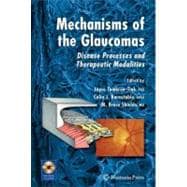
Note: Supplemental materials are not guaranteed with Rental or Used book purchases.
Purchase Benefits
What is included with this book?
| Preface | p. vii |
| Contributors | p. xv |
| Companion CD | p. xix |
| Epidemiology of Glaucoma | |
| Age and Racial Variation in the Prevalence of Open-Angle Glaucoma in the USA | p. 3 |
| Epidemiology of and Risk Factors for Primary Open-Angle Glaucoma | p. 19 |
| The Reykjavik Eye Study on Prevalence of Glaucoma in Iceland and Identified Risk Factors | p. 35 |
| Defined Glaucoma in Chinese Population | p. 49 |
| The Wroclaw Epidemiological Study Screening Possibilities of Glaucoma Detection | p. 63 |
| Mechanisms of Intraocular Pressure Elevation in the Glaucomas | |
| Pretrabecular Mechanisms of Intraocular Pressure Elevation | p. 83 |
| Glaucomatous Changes in the Trabecular Meshwork | p. 99 |
| Trabecular Mechanisms of Intraocular Pressure Elevation Pseudoexfoliation Syndrome | p. 117 |
| Post-Trabecular Glaucomas with Elevated Episcleral Venous Pressure | p. 139 |
| Angle-Closure Glaucomas Anterior (Pulling) Mechanisms | p. 159 |
| Angle-Closure Glaucomas Posterior (Pushing) Mechanisms with Pupillary Block | p. 167 |
| Angle-Closure Glaucomas Posterior (Pushing) Mechanisms Without Pupillary Block | p. 173 |
| Genetics of Glaucoma | |
| Genetics and Glaucoma Susceptibility | p. 191 |
| Myocilin Mutations and Their Role in Open-Angle Glaucoma | p. 205 |
| The Functional Role of Myocilin in Glaucoma | p. 219 |
| Roles of CYP1B1, Optineurin, and WDR36 Gene Mutations in Glaucoma | p. 233 |
| Genetic Association in the Open-Angle Glaucomas | p. 275 |
| ApoE Polymorphisms and Severity of Open-Angle Glaucoma | p. 289 |
| Molecular and Cellular Responses in the Eye to Glaucoma | |
| Changes in Aqueous Humor Dynamics with Age and Glaucoma | p. 311 |
| Mechanosensitive Genes in the Trabecular Meshwork at Homeostasis Elevated Intraocular Pressure and Stretch | p. 329 |
| Reactive Astrocytes in the Glaucomatous Optic Nerve Head Protective and Destructive Mechanisms | p. 363 |
| Optic Neuropathy and Ganglion Cell Degeneration in Glaucoma Mechanisms and Therapeutic Strategies | p. 393 |
| Proteomics in Defining Pathogenic Processes Involved in Glaucomatous Neurodegeneration | p. 425 |
| Proteomic Advances Toward Understanding Mechanisms of Glaucoma Pathology | p. 443 |
| Molecular and Cellular Responses in the Eye to Glaucoma Ocular Gene Expression in Experimental Glaucoma | p. 459 |
| Ocular Tissue and Psychophysiological Responses in Glaucoma | |
| Ocular Biomechanics in Glaucoma | p. 471 |
| Intraocular Pressure, Perfusion Pressure, and Optic Nerve Energy Metabolism | p. 491 |
| Optic Nerve Physiology and Mechanisms of Glaucomatous Atrophy | p. 517 |
| Psychophysiology of Glaucoma From Form to Function | p. 527 |
| Models of Glaucoma | |
| The Primate Model of Experimental Glaucoma | p. 551 |
| Involvement of Inflammation in a Mouse Model of Inherited Pigmentary Glaucoma | p. 579 |
| Use of Purified Retinal Ganglion Cells for an In Vitro Model to Study Glaucoma | p. 601 |
| Therapeutic Modalities | |
| Pharmacological Therapies for Managing Glaucoma | p. 611 |
| Redox-Based Therapies for Neuroprotection | p. 645 |
| Neuroprotective Signaling Pathways in Glaucoma | p. 657 |
| Role of Selective Laser Trabeculoplasty in the Management of Glaucoma | p. 683 |
| Mechanisms and Mechanics of Incisional Surgery for Glaucoma | p. 693 |
| Aqueous Shunts | p. 715 |
| New Approaches to the Surgical Management of the Glaucomas | p. 739 |
| Index | p. 753 |
| Table of Contents provided by Ingram. All Rights Reserved. |
The New copy of this book will include any supplemental materials advertised. Please check the title of the book to determine if it should include any access cards, study guides, lab manuals, CDs, etc.
The Used, Rental and eBook copies of this book are not guaranteed to include any supplemental materials. Typically, only the book itself is included. This is true even if the title states it includes any access cards, study guides, lab manuals, CDs, etc.